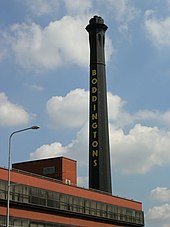Strangeways, Manchester
Strangeways is an area of inner north Manchester, England, around Strangeways Prison just north of the city centre.
Toponomy

Strangeways was recorded in 1322 as Strangwas, from the Anglo-Saxon Strang and gewæsc meaning "[a place by] a stream with a strong current". It was also recorded as Stranways (1323), Strangways (1326), Strangewayes (1546), Strangwyshe (1551), and Strang wayes (1577).[1] The Strangways family originated in the village adopted the earlier spelling as a surname.[2]
Until the 19th century, Strangeways was a rural village, with Strangeways Hall, Park and Gardens.
Strangeways Brewery

Strangeways Brewery was famous as the home of Boddingtons Bitter. It closed in 2005 and was demolished in 2007.[3]
Timeline
- 1459: First known mention of the de Strangeways family in the area.
- 1544: A settlement document describes widespread property attached to Strangeways Hall, including 24 houses, 20 town properties, 20 cottages, and various land up to several miles away.
- 1641: Strangeways Hall appears on a map. It was in Elizabethan or Jacobean style.
- 1624: John Hartley (1609-1655) bought Strangeways Hall. His father Nicholas Hartley and elder brother Richard were wool merchants in Manchester.
- Early 18th century: A grey stucco, palladian-style addition to Strangeways Hall was built.
- 1713: The Reynolds family took over the hall.
- 1768: Francis Reynolds granted a lease to Robert Norton to build a house and silk dyeing works by the Hall's fish pond.
- 1777: Strangeways Hall first known to be let to a tenant (Hugh Oldham).
- 1788: Strangeways Hall was run as a girls' boarding school.
- 1816: Start of the area being built over with houses.
- 1838: Land in Strangeways area was sold to the Manchester and Leeds Railway Company; Manchester Victoria station is there now.
- 1858: Strangeways Hall demolished and its materials sold
- 1859: A newspaper report that the Hall was "several times rebuilt".
- 1864: Completion of building of the Assize Courts on the site of Strangeways Hall. (It was destroyed in the 1939-1945 Blitz and its site is now a car park on Great Ducie Street).
- 1868: Strangeways Prison opened. It was built on the site of Strangeways Hall's fish ponds.
- late 19th century: Jewish immigration to the area, fleeing from violence in Russia.
References
- ^ Ekwall, Eilert (1922). The Place-names of Lancashire. The University Press. p. 33. Retrieved 7 September 2024.
- ^ Burke, Bernard (1898). A Genealogical and Heraldic History of the Landed Gentry of Great Britain & Ireland. Harrison & sons. p. 1416. Retrieved 7 September 2024.
- ^ Rooth, Ben (16 March 2007). "The bitter end for Boddies". Manchester Evening News. Retrieved 22 October 2011.
External links
- Link to part of Pigot's map of Strangeways area in 1813; the blue arrow marks Strangeways Hall.
- Development of Strangeways
- Image of Strangeways Hall c.1840
53°29′35″N 2°14′38″W / 53.493°N 2.244°W
